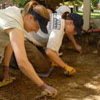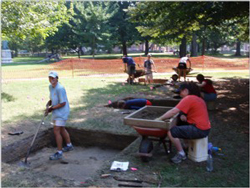
“Nothing we do out here is routine,” says Ph.D. Anthropology student Mark Kostro. “Archeology can open your eyes to experience a way of knowing things that you didn’t know before.”


The Brafferton's role as an Indian school ended with the American Revolution, and over the course of the 19th and early 20th centuries, the building served as a student dormitory, faculty apartment, library and dining hall. This unique history makes the building a particularly interesting site for archaeologists and historians.
Beginning in late May of 2011, an extensive archaeological excavation was carried out prior to the renovation of the historic 1723 Brafferton building at William & Mary. Archaeologists from Colonial Williamsburg Foundation's Department of Architectural and Archaeological Research oversaw the excavation in partnership with William & Mary's Department of Anthropology and Virginia Indian archaeologists.
The Brafferton Project follows previous collaborations between the university and Colonial Williamsburg that provided undergraduates unique opportunities to participate in archaeological research. These investigations examined the beginning years of William & Mary, and in this case, explored its early mission as an institution where "the youth may be piously educated in good letters and manners, and that the Christian faith may be propagated amongst the Western Indians, to the glory of Almighty God."[1]
Involving students in the Brafferton Project extends beyond archaeological fieldwork, and includes training for students who wish to engage in public interpretation of the site as the excavation progresses.
[1] Charter of the College of William & Mary, Swem Library, Special Collections, William & Mary.

“Nothing we do out here is routine,” says Ph.D. Anthropology student Mark Kostro. “Archeology can open your eyes to experience a way of knowing things that you didn’t know before.”

Field school teaching assistant and Ph.D. candidate Ashley Atkins uncovers her past at the historic 1723 Brafferton, a building originally designed to house the College’s Indian School.